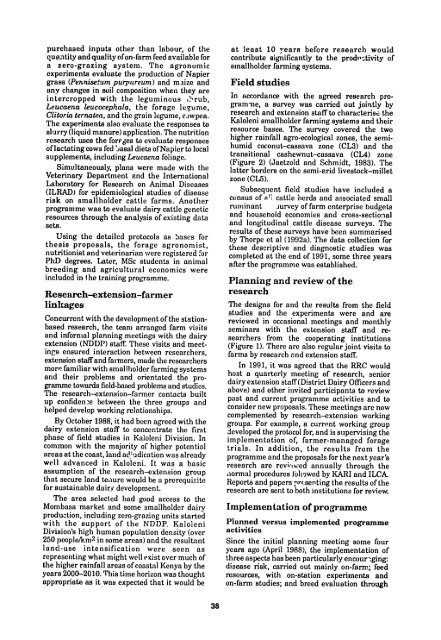aistand south~ern afrkca - (PDF, 101 mb) - USAID
aistand south~ern afrkca - (PDF, 101 mb) - USAID
aistand south~ern afrkca - (PDF, 101 mb) - USAID
You also want an ePaper? Increase the reach of your titles
YUMPU automatically turns print PDFs into web optimized ePapers that Google loves.
purchased inputs other than labour, of the<br />
quantity and quality ofon-farm feed available for<br />
a zero-grazing system. The agronomic<br />
experiments evaluate the production of Napier<br />
grass (Pennisetumpurpureum) and maize and<br />
any changes in soil composition when they are<br />
intercropped with the leguminous ,>rub,<br />
Leucaena leucacephala, the forage legume,<br />
Clitoris ternatea, and the grain legume,cjwpea,<br />
The experiments also evaluate the responses to<br />
slurry (liquid manure) application. The nutrition<br />
research oflactating uses ows the fed forages 'jasa to diets evaluate<br />
of Napier responses<br />
to local<br />
supplements,including Leucaena foliage<br />
Simultaneously, plans were made with the<br />
Veterinary Department and the International<br />
Laboratory for Research on Animal Diseases<br />
(ILRAD) for epidemiological studies of disease<br />
risk on smallholder cattle farms. Another<br />
programme<br />
resources<br />
was to evaluate dairy cattle genetic<br />
through<br />
sets.<br />
the analysis of existing data<br />
Using the detailed protocols as bases for<br />
thesis proposals, the forage agronomist,<br />
nutritionist and veterinarian were registered for<br />
PhD degrees. Later, MSc students in animal<br />
breeding and agricultural economics were<br />
included in Ihe training programme.<br />
Research-extension-farmer<br />
linkages<br />
Concurrent with the development of the stationbased<br />
research, the team arranged farm visits<br />
and informal planning meetings with the dairy<br />
extension (NDDP) staff. These visits and meetings<br />
ensured interaction between researchers,<br />
extension staff and fanmers, made the researchers<br />
more familiar with smallholder farming systems<br />
and their problems and orientated the programme<br />
towards field-based problems and studies,<br />
up The confiden~e research-extension-farmer between the three contacts groups built and<br />
helped develop working relationships.<br />
By October 1988, it had been agreed with the<br />
dairy extension staff to concentrate the first<br />
phase of field studies in Kaloleni Division. In<br />
common with the majority of higher potential<br />
areas at the coast, land ad:udication was already<br />
well advanced in Kaloleni. It was a basic<br />
assumption of the research-extension group<br />
that secure land texure would be a prerequisite<br />
for sustainable dairY development,<br />
The area selected had good access to the<br />
Mo<strong>mb</strong>asa market and some smallholder dairy<br />
production, including zero-grazing units started<br />
with the support of the NDDP. Kaloleni<br />
Division's high human population density (over<br />
250 people/km 2 in some areas) and the resultant<br />
land-use intensification were seen as<br />
representing what might well Pxist over much of<br />
the higher rainfall areas of coastal Kenya by the<br />
years 2000-2010. This time horizon was thought<br />
appropriate as it was expected that it would be<br />
38<br />
at least 10 years before research would<br />
contribute significantly to the prodi',tivity of<br />
smallholder farming systems.<br />
Field studies<br />
In accordance with the agreed research pro-<br />
In ar e w a areed out programne,<br />
a survey was carried out jointly by<br />
research and extension staff to characterise the<br />
Kaloleni smallholder farming systems and their<br />
resource bases. The survey covered the two<br />
higher rainfall agro-ecological zones, the semihumid<br />
coconut--cassava zone (CL3) and the<br />
transitional cashewnut-cassava (CL4) zone<br />
(Figure 2) (Jaetzold and Schmidt, 1983). The<br />
latter borders on the semi-arid livestock-millet<br />
zone (CL5).<br />
Subsequent field studies have included a<br />
suseq e eds ndaveoiated a<br />
census of s; cattle nerds and associated small<br />
ruminant jurvey of farm enterprise budgets<br />
and household economies and cross-sectional<br />
and longitudinal cattle disease surveys. The<br />
results of these surveys have been summarised<br />
by Thorpe et al (1992a). The data collection for<br />
these descriptive and diagnostic studies was<br />
completed at the end of 1991, some three years<br />
after the programme was established.<br />
Planning and review of the<br />
research<br />
The designs for and the results from the field<br />
studies and the experiments were and are<br />
reviewed in occasional meetings and monthly<br />
seminars with the extension staff and researchers<br />
from the cooperating institutions<br />
(Figure 1). There are also regular joint visits to<br />
farms by research and extension staff.<br />
In 1991, it was agreed that the RRC would<br />
host a quarterly meeting of research, senior<br />
dairy extension staff (District Dairy Officers and<br />
above) and other invited participants to review<br />
past and current programme activities arid to<br />
consider new proposals. These meetings are now<br />
complemented by research-extension working<br />
groups. For example, a current working group<br />
developed the protocol for, and is supervising the<br />
implementation of, farmer-managed forage<br />
trials. In addition, the results from the<br />
programme and the proposals for the next year's<br />
research are rev(.wed annually through the<br />
normal procedures olwed by KARI and ILCA.<br />
Reports and papers preserting the results ofthe<br />
research are sent to both institutions for review.<br />
Implementation of programme<br />
Planned versus implemented programme<br />
activities<br />
Since the initial planning meeting some four<br />
years ago (April 1988), the implementation of<br />
three aspects has been particularly encour-.ging:<br />
disease risk, carried out mainly on-farm; feed<br />
resources, with on-station experiments and<br />
on-farm studies; and breed evaluation through

















